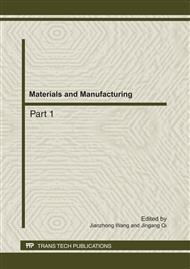p.550
p.554
p.558
p.562
p.566
p.572
p.576
p.580
p.584
Study on the Influence of Different Pulse Temperatures on Al-22%Si Alloy Solidification Structure
Abstract:
Taking the hypereutectic Al-Si alloy as the research object, the fading characteristics of Al-22% Si alloy at different pulse temperatures are investigated in this paper in order to analyze the mechanism of electrical pulse modification to the alloy. We can get the conclusion by observing the microstructure of the sample, measuring the microhardness and calculating the volume fraction and the average size of primary silicon: at different pulse temperatures, the effect of electric pulse modification is fading with static duration prolonging; meanwhile, with the temperature upward, the modification effect and fading trends to be weak, which indicates the best pulse temperature is one of the important factors to influence the modification effect.
Info:
Periodical:
Pages:
566-571
Citation:
Online since:
July 2011
Authors:
Price:
Сopyright:
© 2011 Trans Tech Publications Ltd. All Rights Reserved
Share:
Citation:


